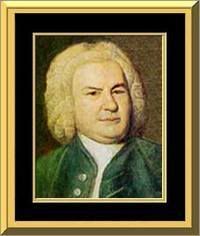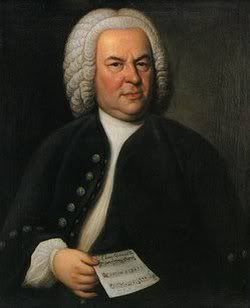And now for something really boring…let’s talk about classical music.

I guess I’ll start off with a question…how many of you think the Goldberg Variations are about the wrestler? Maybe a book or a movie chronicling diabolical cloning experiments of wrestler Goldberg gone awry? Close…but not exactly.
The Goldberg Variations are one of those pieces of music with a colorful story that may, or may not, be true depending on who you ask. The most widely accepted version of that story is that Johann Sebastian Bach composed the Goldberg Variations for an insomniac Count by the name of Keyserlingk who happened to be the Court of Dresden’s Russian Ambassador. Johann Gottlieb (Theophilus) Goldberg was a harpsichordist in the employ of Keyserlingk who routinely played Bach’s composition for the Count during his bouts of insomnia and whose name the piece eventually claimed as its own.
Delving into the more unsubstantiated and inaccurate realms of history for a fun and slightly disturbing point of interest…Keyserlingk was actually appointed to his ambassadorship by none other than Catherine the Great, who, again, may or may not have died while trying to mount her beloved steed…in the biblical sense.
Now back to our regularly scheduled program.

Some of the musical powers that be apparently take issue with a few small facts in the Keyserlingk/Goldberg story such as, at the time of it’s publishing in 1742, the piece didn’t have a dedication and Bach’s own “brief” title for the piece was not the Goldberg Variations but “Keyboard Practice consisting of an Aria with Diverse Variations for the Harpsichord with two Manuals Composed for Music Lovers, to Refresh their Spirits”…which I think history would have found equally as popular, as it rolls off the tongue so well. There is also some doubt as to whether or not Goldberg, being only fourteen or fifteen at the time, would have had the technical ability on the harpsichord to pull off the piece’s technical demands.
So now that you know what it is, you may be wondering why I chose to call this, The Goldberg Variations or Three Sides to Every Story? No? Oh, well...I’m going to tell you anyway.

I am the proud owner of three different recordings of the Goldberg Variations, two of them by the same pianist. The first one I purchased was Glenn Gould’s 1955 landmark recording of the piece, followed by his 1981 recording where he revisited the Bach composition. The last version I purchased was the 1999 recording by pianist Rosalyn Tureck.
Despite the obvious reasons these three recordings should be similar, they could not be more different. One of the most obvious reasons for that has to be the running time of the recordings. Gould’s 1955 recording runs a mere 38 minutes while his 1981 version was stretched to just over 51 minutes and Tureck’s 1999 recording clocks in at nearly an hour and a half. It would be easy to try and think of these recordings in terms of modern popular music and not understand how that could be possible. However, if you take the time to sit down with each of these albums, from the very first notes, the reason becomes obvious.
Interpretation is everything, and while you would expect variance between performers to some degree, Gould shows how age and experience can chance a person. In listening to the two Goldberg Variation recordings by Glenn Gould, the listener can literally hear him mature as a musician, a performer and a person.
Glenn Gould was 23 years old when he recorded the Goldberg’s for the first time, technically it was the second time as there is a recording of a CBC performance from 1954, however the 1955 performance was the first studio recording of both Gould’s career and of his playing of the Goldberg Variations. Variation 5 is perhaps the best representation of the 1951 Gould recording. In it, a young and painfully talented Gould sits at the keyboard and rockets through the passage like a speeding train. The keys show him no resistance and it’s almost as if the natural laws do not apply to him in the thirty-seven seconds it takes him to complete the piece. He unleashes so much energy, and almost a bit of arrogance, in his mastery of the movement that when Variation 6 begins slower, it is almost painful to hear.

Through the time machine that is recorded music, the listener is then able to jump forward 26 years, more than double Glenn Gould’s age at the time of the 1955 recording, to 1981 and hear the 49 year old Gould replay the Goldberg Variations near the end of his musical and corporeal life, he would die a short year later on October 4, 1982. From the opening notes of the Aria, you can tell that this is not the same man as the youthful boy in 1955. There is a solemnity in the performance that does not appear in 1955.

One of the most endearing, or annoying, aspects to both of the Gould recordings is Gould himself. Not only here, but in all of his recordings, Gould would vocalize the notes as he played. If you listen closely…and sometimes not that closely, you can hear the pianist literally singing along with himself. In the sense of a clean recording, it can be distracting at times, but as a record of a performer, it can be fascinating.
That leads us to the Tureck recording from 1999. Rosalyn Tureck’s approach to the Goldberg Variations is altogether different than Glenn Gould’s and even though the music is the same, this could be an entirely different composition than the Bach performed by Gould. While both of the Gould recordings exude technique, Tureck radiates feeling. That is not to say that she is not enormously technically proficient, it is just that she is in no rush to find the soul of the Variations she is playing. The notes here are carefully chosen and the overall effect is similar to watching a garden grown. The seeds are the original Bach score and under Rosalyn Tureck’s capable hands, the score blooms. The Variations seem to flower under her touch. To me, the recording captures such a unique performance of the Variations that is worthy of existing on its own merits, regardless of the fact that it is of a celebrated Bach piece.

If you haven’t been able to tell, I love Bach. He is my absolute favorite composer of all time. Others can claim Mozart or Beethoven, but please leave Bach to me. The music of Johann Sebastian Bach is full of mathematical precision and relentless technique, but also interminable depth and profuse feeling. I don’t think you could have two better examples of those qualities than Glenn Gould and Rosalyn Tureck.
























No comments:
Post a Comment